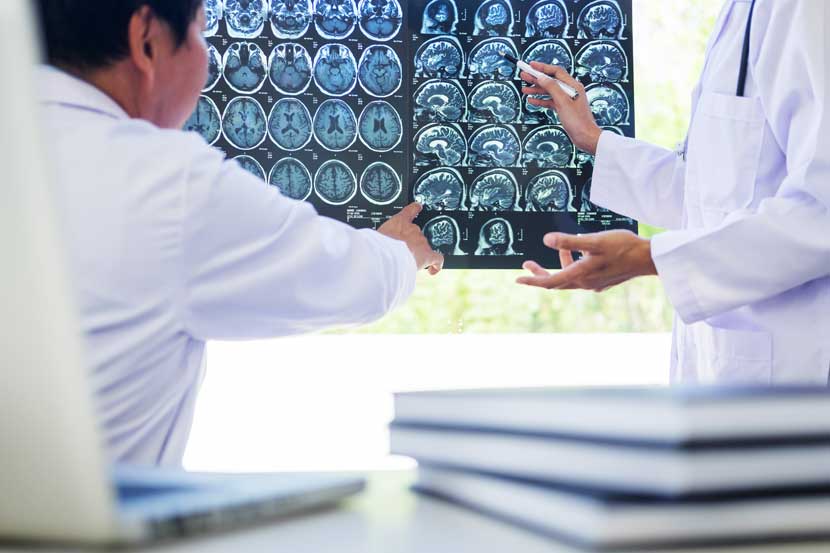Head Injury / Traumatic Brain Injury

What Is a Head Injury?
The human brain is a complicated structure. It is a maze of interconnected vessels, nerves, and tissue that controls everything from thinking to the most basic fundamentals of life, including breathing and heartbeat.
A head injury can involve damage to the brain, scalp, and/or skull. A traumatic brain injury is an injury to the brain itself. The nature of the deficit that results from a head injury depends on the location of the injury and its severity. Head injuries are commonly treated by neurologists and/or neurosurgeons.
There are 4 basic areas of the brain. These are:
- Brain Stem, manages vital life functions like heart beat and breathing;
- Cerebellum, which coordinates body movement;
- Diencephalon, relays both motor and sensory signals to specific parts of the brain;
- Cerebrum, controls reasoning, learning, emotion, vision, hearing as well as other functions.
Common Traumatic Brain Injury
Traumatic Brain Injury, is a type of head injury and refers to the disruption of normal brain function. This can be by caused a blow, jolt or an object penetrating through the skull and impacting brain tissue. Common signs of traumatic brain injury include loss of/decreased consciousness, amnesia as well neurological deficits such as loss of vision, muscle weakness, and difficulty in speech. There can also be disorientation, difficulty concentrating, and slow thinking with traumatic brain injury.
There are three basic types of Traumatic Brain Injury:
Mild: Usually associated with nausea, dizziness and/or headache. These symptoms tend to resolve within a shorter period of time;
Moderate: Symptoms can include loss of consciousness, vomiting and dilation of the pupils.
Severe: Hallmark signs include loss of consciousness, slurred speech and confusion.
Moderate to severe brain injuries can result in extended periods of coma, intensive medical care and even death.
What Is A Concussion?
Concussion is a form of mild traumatic brain injury. The American Academy of Neurology suggests that it manifests as an, “alteration in cranial function affecting memory, orientation and may sometimes result in a loss of consciousness.”
A direct trauma to the head, or an acceleration-deceleration type whipping of the head that commonly occurs as a result of a car accident, can cause a concussion. Concussion signs and symptoms can include confusion, difficulty walking, seizures, vomiting, abnormal vision, irritability, balance issues, and loss of consciousness leading to a brief period of amnesia, in extreme cases.
What is a Subdural Hematoma?
A subdural hematoma occurs when blood accumulates between the subarachnoid layer and another layer of the brain called the dura. Symptoms of subdural hematoma include alteration in mental state, dilated pupils, dizziness, nausea and vomiting, and a lingering headache.
There are three types of subdural hematoma; acute, subacute, and chronic. Acute hematoma is most dangerous with symptoms appearing immediately after an injury to the brain.
A patient can become unconscious or paralyzed when this condition is not timely diagnosed and treated. Symptoms of a subacute hematoma may appear days or weeks after brain injury, and are usually associated with concussion type symptoms.
Chronic subdural hematoma is common in older people, with symptoms appearing after weeks or months of sustaining the trauma. These patients sometimes fail to recall the cause of the brain injury.
What is a Skull Fracture?
A skull fracture is a disruption or break in any of the bones that form your skull. An impact to the head strong enough to break a bone can cause a skull fracture.
Skull fracture symptoms include facial bruising, bleeding from the nostrils or ears, and swelling or tenderness around the area where the impact occurred. There are many different types of skull fractures, including, closed fracture, open fracture, depressed fracture, and basal fracture.
How Can An Accident Cause A Head Injury?
A injury to the brain can result from a violent jolt or blow to the head. These types of forces to the head are very common in car accidents, falls and sports injuries. Ultimately, the force of the impact, and the location of the strike, are important predictors of the severity of the injury.
Cerebral spinal fluid surrounds and cushions the brain within the skull. This fluid barrier, together with the tough bones of the skull, protect the brain from direct impact. Imagine trying to break an egg floating in fluid inside a hard plastic container by striking the outside of the container. This would be very difficult to do. Similarly, your brain is protected from the forces of trauma because it is essentially floating in cerebral spinal fluid, surrounded by the hard bones of the skull.
However, a sudden jolt to the head can cause the brain to slosh around and strike the inside of the skull causing injury. This is one of the most common mechanisms for accident related brain injury.
Common Head Injury Symptoms
The symptoms of a head injury vary largely, depending upon the severity of the injury. Some common symptoms, however, include the following:
- Lethargy and fatigue;
- Vomiting;
- Persistent headache;
- Lasting confusion;
- Paralysis;
- Loss of consciousness, sometimes resulting in a coma;
- Amnesia;
- Dizziness;
- Difficulty in concentrating and balancing;
- Vision-related problems including blurred vision, loss of eye movement, and sometimes even blindness;
- Breathing issues (with increased blood pressure);
- The appearance of cerebral spinal fluid from ears or nose;
- Body numbness;
- Loss of bowel control; and
- Slow pulse.
Testing Used To Diagnose Head Injury
CT Scans and MRIs are quite effective in diagnosing head injuries.
CT Scan (Computerized Tomography Scan)
A CT scan can be performed in the emergency room when a head injury is suspected. These scans use x-rays to produce detailed images of the brain. A CT scan can disclose skull fracture, hematoma, hemorrhage, brain tissue swelling, and other related conditions.
MRI (Magnetic Resonance Imaging)
MRI is an effective diagnostic tool that provides detailed imaging of the brain and its structures. Using a combination of magnetic and radio waves, this type of scanning is painless, safe and effective.
Non-Surgical Treatment For Brain Injury
The nature of the treatment necessary for a head injury depends on the severity of the injury. Some mild brain injuries require no formal treatment, other than rest and over the counter medication. Others, however, require monitoring, medication and followup with a neurologist.
A neurologist can assess your condition using neuropsychological testing and techniques, as well a thorough neurological examination. Your neurologist may also prescribe medication to help alleviate lingering symptoms you may have, including headache, nausea and other related problems.
Some patients who sustain a head injury may need to see a mental health provider to address feelings of anxiety and depression related to the injury.
Surgical Treatment For Brain Injury
Brain injury may sometimes require surgical management by a neurosurgeon. Some procedures commonly performed by neurosurgeons include:
- Removing hematoma;
- Repairing skull fractures;
- Surgery to stop bleeding in the brain; and
- Opening a window in the skull to relieve pressure by draining cerebral spinal fluid or creating a window in the skull to provide more room for swollen brain tissues.

